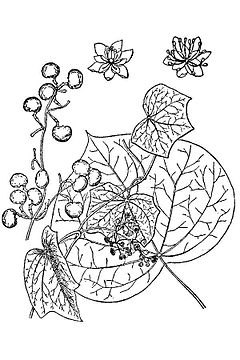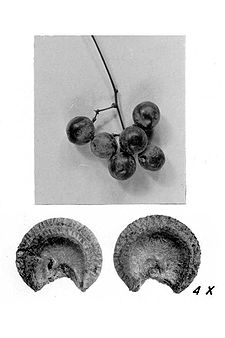- Menispermum canadense
-
Canadian Moonseed 
Scientific classification Kingdom: Plantae (unranked): Flowering plants (unranked): Eudicots Order: Ranunculales Family: Menispermaceae Genus: Menispermum Species: M. canadense Binomial name Menispermum canadense
L.Menispermum canadense (Canadian Moonseed, Common Moonseed, or Yellow Parilla) is a flowering plant in the family Menispermaceae, native to eastern North America, from southern Canada south to northern Florida, and from the Atlantic coast west to Manitoba and Texas.[1] It occurs in thickets, moist woods, and the banks of streams.
Contents
Growth
It is a woody climbing vine growing to 6 m tall. The leaves palmately lobed, 5-20 cm diameter with 3-7 shallow lobes, occasionally rounded and unlobed. The fruit are produced in 6-10 cm diameter clusters of purple-black berries, each berry is 1-1.5 cm in diameter. The seed inside the berry resembles a crescent moon, and is responsible for the common name. The fruit is ripe between September and October, the same general time frame in which wild grapes are ripe.
Both the leaves and fruit resemble that of the Fox Grape (Vitis labrusca); confusion can be dangerous as Moonseed fruit is poisonous, unlike the edible Fox Grape fruit.
The root is a rhizome, so one specimen can form colonies of genetically identical plants.
Toxicity
All parts of these plants are known to be poisonous.[2] The principal toxin is the alkaloid dauricine.[3] The fruit of Canada Moonseed are poisonous and can be fatal. While foraging for wild grapes one should examine the seeds of the fruit to make sure one is not eating moonseeds: moonseeds have a single crescent-shaped seed, while grapes have round seeds. Differences in taste should also be an indicator of whether or not a specimen is grape or Moonseed, moonseeds have a taste that is described as "rank". Also, the moonseed vine lacks tendrils, whilst the vine of the wild grape has forked tendrils.[4]
Traditional uses
The Cherokee used Moonseed as a laxative, and as a gynecological and venereal aid. The root was used for skin diseases. The Lenape used it in a salve for sores on the skin.[5] It has been used for a variety of medicinal uses by Americans of European descent.[6]
References
Notes
- ^ "Menispermum canadense". Flora of North America. http://www.efloras.org/florataxon.aspx?flora_id=1&taxon_id=220008359.
- ^ FDA Poisonous Plant Database
- ^ "Menispermum canadense". Poisonous Plants of North Carolina, Alice B. Russell Department of Horticultural Science; James W. Hardin, Larry Grand, and Angela Fraser. North Carolina State University. http://www.ces.ncsu.edu/depts/hort/consumer/poison/Menisca.htm.
- ^ Peterson, Lee, "A Field Guide to Edible Wild Plants of Eastern and Central North America", p. 50, Houghton Mifflin Company, New York City, accessed 22 November, 2010. ISBN 0 395 20445 3
- ^ Native American Ethnobotany Database (University of Michigan - Dearborn): Moonseed
- ^ Dr. Duke's Database of USDA GRIN Taxonomy: Canadian Moonseed
General references
- Lee Allen Peterson, Edible Wild Plants, (New York City: Houghton Mifflin Company, 1977), p. 50.
External links
Categories:- Ranunculaceae
- Flora of the Eastern United States
- Medicinal plants
- Poisonous plants
Wikimedia Foundation. 2010.

